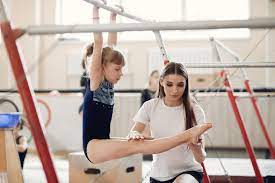From the moment a child attempts their first forward roll, gymnastics becomes more than just a sport. It’s a tool for total development—physical, cognitive, and emotional. For families considering ways to help their child grow confidently and stay active, gymnastics for kids offers unmatched benefits.
It’s not about reaching elite levels or learning complex tricks. At its heart, gymnastics builds strong bodies and sharp minds—setting children up for a lifetime of healthy movement, focus, and resilience.
In this article, we explore the deep and lasting impact gymnastics has on children’s physical and mental development—and why it remains one of the best foundational sports for young Australians today.
Whole-Body Strength, One Skill at a Time
Gymnastics is one of the most effective ways to develop physical literacy. Unlike sports that focus on a single skill, gymnastics encourages kids to move in all directions—jumping, balancing, climbing, rolling, and inverting.
These varied movements improve:
- Core stability and posture
- Grip strength and upper-body coordination
- Balance and proprioception (body awareness)
- Joint flexibility and dynamic control
What’s unique is that kids build this strength using their own body weight. This makes it a safe, scalable option for young children whose bones and joints are still developing.
The result? Children gain a physical foundation that supports every other sport they may try—from gymnastics for kids to field games, swimming, or structured team activities like tape ball indoor cricket.
Boosting Mental Focus and Memory
In every gymnastics class, children are asked to follow instructions, recall movement sequences, and execute them under guidance. This isn’t just exercise—it’s brain training.
Gymnastics supports:
- Working memory: remembering and applying multi-step routines
- Focus: staying attentive during demonstrations
- Problem-solving: adjusting posture or timing to complete a move
- Goal setting: practising specific skills over time to see improvement
According to Harvard Health, regular physical activity boosts memory, attention, and planning by increasing blood flow to the brain and encouraging neuroplasticity. In young children, this effect is even more pronounced.
So while your child is practising a handstand, they’re also strengthening the same mental pathways used for reading, maths, and self-regulation.
Encouraging a Healthy Relationship With Risk
Gymnastics teaches children to try new things while respecting boundaries. Coaches guide students through progressions that start simple and become more complex as confidence grows.
Kids learn:
- How to fall safely
- When to ask for help
- The difference between bravery and recklessness
This structured exposure to risk helps develop courage and body awareness—without putting kids in danger. It also improves emotional regulation. Children gain the ability to stay calm under pressure, manage fear, and push through uncertainty.
Over time, this translates into broader confidence. A child who once hesitated to try a forward roll may later volunteer to speak in class, join a new team, or take on leadership roles in other settings.
Building Resilience Through Repetition
Few sports reinforce the importance of patience and repetition like gymnastics. Progress isn’t instant. It comes from trying, failing, refining, and eventually succeeding.
Each skill learned is a mini life lesson:
- A missed cartwheel shows the value of trying again.
- Holding a pose on the beam teaches patience.
- Learning to fall and get back up teaches grit.
These micro-moments help children develop a growth mindset—the belief that ability is built, not given. It’s a lesson that serves them well not only in school, but in friendships, future sport, and life beyond.
Social Skills Without the Pressure of Team Sport
For children who may not feel comfortable in competitive team environments, gymnastics offers a refreshing alternative. While kids train alongside others, the focus is on personal progress—not performance comparisons.
This makes it ideal for children who:
- Thrive in smaller group settings
- Enjoy movement but feel overwhelmed by team dynamics
- Need time and space to build confidence
That said, gymnastics still fosters important social behaviours like taking turns, respecting space, listening to peers, and offering encouragement. These skills prepare children for future participation in team-based activities like tape ball indoor cricket, where collaboration is key.
A Sport That Grows With Your Child
The great thing about gymnastics is that it grows with your child. Whether they stay in recreational classes or eventually explore other sports, the skills they learn continue to serve them.
It suits:
- Toddlers learning to balance and explore
- Primary-aged children developing focus, agility, and strength
- Older kids looking to cross-train or build confidence in other sports
Even if your child never competes, the lessons are lasting. They learn to move well, think clearly, and believe in themselves—all in one class.
Real-Life Impact: Ava’s Story
Ava, aged 9, was a bright student with a tendency to overthink. She avoided sport, often fearing failure or “getting it wrong.” Her parents enrolled her in recreational gymnastics to help her reconnect with movement and reduce stress.
At first, she was cautious. But over time, the consistent coaching and supportive environment gave her space to grow. She discovered she loved practising routines, slowly built up her strength, and started to smile more when she moved.
Six months in, Ava stood taller—literally and figuratively. She even joined a gymnastics for kids group that combined movement with playful indoor games. Her teachers noticed improved confidence and participation in class.
Gymnastics didn’t just make her more active. It helped her believe in her own ability to grow.
Final Word: Strength Beyond the Mat
Gymnastics is often seen as a sport of strength and skill—but it’s much more than that. For children, it’s a tool for total development. It helps them build healthy bodies, focused minds, and resilient spirits.
Whether they dream of flips or simply want to move with joy, gymnastics for kids offers the structure and freedom to help them thrive. And when paired with other fun, social activities like tape ball indoor cricket, it becomes part of a lifelong love for sport and movement.
Gymnastics isn’t about perfection—it’s about progress. One roll, jump, and leap at a time.

